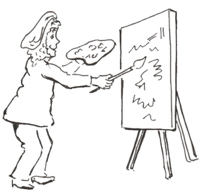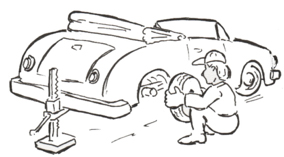Sort Articles:
Tools That Work
Written by: Ralph Twombly
Published: Mon Nov 23 2020 15:00:41 GMT-0500 (Eastern Standard Time)
“Give us the tools and we will finish the job.”
Winston Churchill
In our work, we learned long ago that the audience is always split. Many want to learn the “why” of business and people, and many want tools to help them execute. This section is filled with some of our most often used tools. The “why” is touched upon, but I have used much of them in previous sections and saved some for future sections. Early in my career, these tools were a revelation to me. I have included them because it occurred to me that many of the people who come to us have not had a lot of exposure to them, thereby losing the ability to get real value from their group or team.

If tools are your thing, you will probably enjoy what follows.
With tool kits, managers can enhance their effectiveness.
If you were planning to build a shelf or repair a plumbing problem, what’s the first thing you might do in order to make the project go smoothly? You would likely find the needed tools and have them at hand along with your materials. While that may be the tedious part of any project, the right tools are essential to building the perfect shelf. It’s the same with managing people. Knowing what tools to use in different situations can make a tremendous difference in your outcome. There are a number of tried-and-true management tools. If you are not fond of details, this might be a tough section, but please bear with me. My goal is to provide a few tools that give managers a variety of ways to work with their teams. Over the years, I have learned everything from fish-bone diagrams to Gannt Charting and I always come back to just a few of the easy ones. You may not feel that all of the application tools apply to your business or team but, honestly, each has value in different situations. While I invented none of these tools, I have applied each and have seen each applied successfully. Each can be applied in a variety of business situations from manufacturing to banking and everywhere in between.
Here is a list of the ideas and tools that follow:
- How People Learn
- Problem Solving Technique
- Mind Mapping
- Systems Diagramming
- Fool-Proof Delegation
Why tools are important for managers
“Man is a tool-using animal...Without tools he is nothing.
With tools he is all .”
Thomas Carlyle
The first time I was promoted, the feeling of responsibility set in shortly after the celebration. The responsibility I felt was to be that person who people would turn to for guidance as a leader. All the questions that I had been asking of my managers were now being asked of me. They were questions like, “How do I set goals?” or “Do you think I should take that posted job?” and, “What should I do with Billy or Marcy who don’t seem to want to cooperate?” Just to be fair, I grew up in a rough and tumble environment and felt like I had a lot to learn. Maybe the language quoted above sounded a little different to you, but I bet you get my drift.
One thing that I didn’t have as a new manager was tools. I watched other managers drop into a meeting, go to a flipchart or chalk board and start to draw an idea that captivated the rest of the people in attendance. The idea grew into a plan and the plan gained champions and off we went to get things done. It never dawned on me that maybe the manager had something in their head to work from beyond a wild idea. Maybe they had a tool.
How Tools Work
“No man is born into this world whose work is not born with him;
there is always work and tools to work withal…”
James Russel Lowell
People learn visually.
 Here’s a quick little nugget with which I’m sure you will agree. People love to see things represented visually as they learn something new. Like most people, I love to see people write and illustrate on flipcharts, glass, white boards, or even on single sheets of paper. We have figured out that if we get in a room with a new or prospective client and a white board or flipchart is available, we can make a greater impact and the sale more often than not. Because we think like most facilitators and seek to engage visually, we are quick to get to our
Here’s a quick little nugget with which I’m sure you will agree. People love to see things represented visually as they learn something new. Like most people, I love to see people write and illustrate on flipcharts, glass, white boards, or even on single sheets of paper. We have figured out that if we get in a room with a new or prospective client and a white board or flipchart is available, we can make a greater impact and the sale more often than not. Because we think like most facilitators and seek to engage visually, we are quick to get to our  feet and show instead of simply telling.
feet and show instead of simply telling.
People learn abstractly.
Over the years, I have also figured out that people are not linear in thought and, in fact, think and learn abstractly. What this means is that we learn in random patterns and then translate them into manageable models in our minds. Often people will say, “Just tell me the answer!” but in our experience, and as the graph provide by NTL above reinforces, lecturing or simply telling an audience of learners is a less than optimal retention approach.

People pay attention to someone who can ‘take a room’ and includes them in a positive outcome.
 This is kind of important. A person who (hopefully the manager) will at some point take to their feet to engage and manage a discussion will quickly gain the group’s attention and curiosity. While we hope it is you who does this, we still love it when someone, anyone, at just the right moment says confidently, “Okay, let’s see what it looks like,” stands, and finds a way to illustrate the issue and leads the group down a path toward solution.
This is kind of important. A person who (hopefully the manager) will at some point take to their feet to engage and manage a discussion will quickly gain the group’s attention and curiosity. While we hope it is you who does this, we still love it when someone, anyone, at just the right moment says confidently, “Okay, let’s see what it looks like,” stands, and finds a way to illustrate the issue and leads the group down a path toward solution.
People learn by doing.
Ultimately, people learn best by doing. This is called kinesthetic learning and we all respond to it. For instance, all good trainers and developers of people quickly pick up on how ineffective they can be when the only method they have to offer is a lecture. If you don’t find a way as a trainer to build in learning activities, you may find your career in peril as your audience dries up from boredom and disinterest.
 Of course, taking on the ‘learn-by-doing’ approach probably demands a book in itself. What I do know and am glad to share is that the more people touch, practice, create, and build confidence together, the more effective and embedded their take-aways from learning opportunities will become. As a manager, if you can create active and participative ‘learn-by-doing’, your audience will quickly and routinely follow your lead and you will be passing along solid technique at the same time.
Of course, taking on the ‘learn-by-doing’ approach probably demands a book in itself. What I do know and am glad to share is that the more people touch, practice, create, and build confidence together, the more effective and embedded their take-aways from learning opportunities will become. As a manager, if you can create active and participative ‘learn-by-doing’, your audience will quickly and routinely follow your lead and you will be passing along solid technique at the same time.
People need to receive routine and deeply genuine appreciation.
Time after time when receiving expectations from individuals in a team setting, appreciation hovers near the top of the list of needs. Most of us run around saying things like, “I don’t need a pat on the back” or “My work is its own appreciation. If you truly don’t need appreciation, then you are unique. Think of the people you love most in your life never again telling you that they love you. To me, that is terrifying!!
Ralph Twombly
In the 20 years since starting Priority Learning, Ralph has facilitated countless learning experiences and has conducted training for thousands of managers and leaders. With over 30 years of leadership development and organizational development background and work, Ralph continues to build relationships with client companies all over the U.S.

